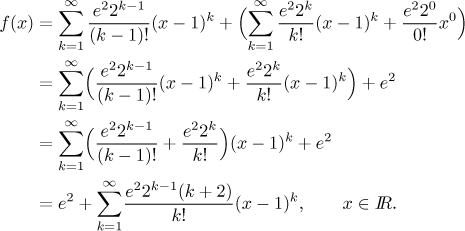Problem: Expand the given function in a power (Taylor) series with the given center:
![]()
Solution:
We use the
standard approach.
We see that once we expand the exponential, our main work is done, the
remaining parts are easy to handle. Thus the given function already has a
reasonable form and we can pass to the first step, changing all x so
that instead we have terms
![]()
If we expand the exponential now, the resulting series will have terms as in its argument, so it will not be a power series with center 1. Thus we need to get rid of the "+2" in the exponential, this is simple using algebra. Similarly we have to get rid of the "+1" in the term in front of the exponential, so we split that expression in two.
![]()
Now we are ready to expand the exponential using the series for
ey, then we rearrange the resulting series so that
the terms

Note that the exponential expansion is valid
for every
We have the answer expressed as a sum of two power series, but it is
expected that we provide one power series. Thus the last step is to put the
two series together. Note, however, that if we add them, we get a series in
which different powers of

Now both series have the same power at x, but they have different
indexing. We see that the second summation has one extra term (when

Remark: What is the point in making one series, when it took us so
much work? When working with series, one often needs to know what is the
coefficient in front of, say,
